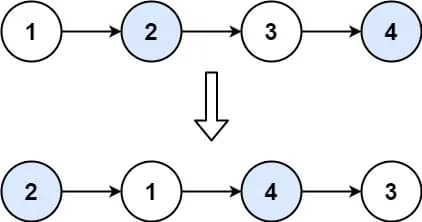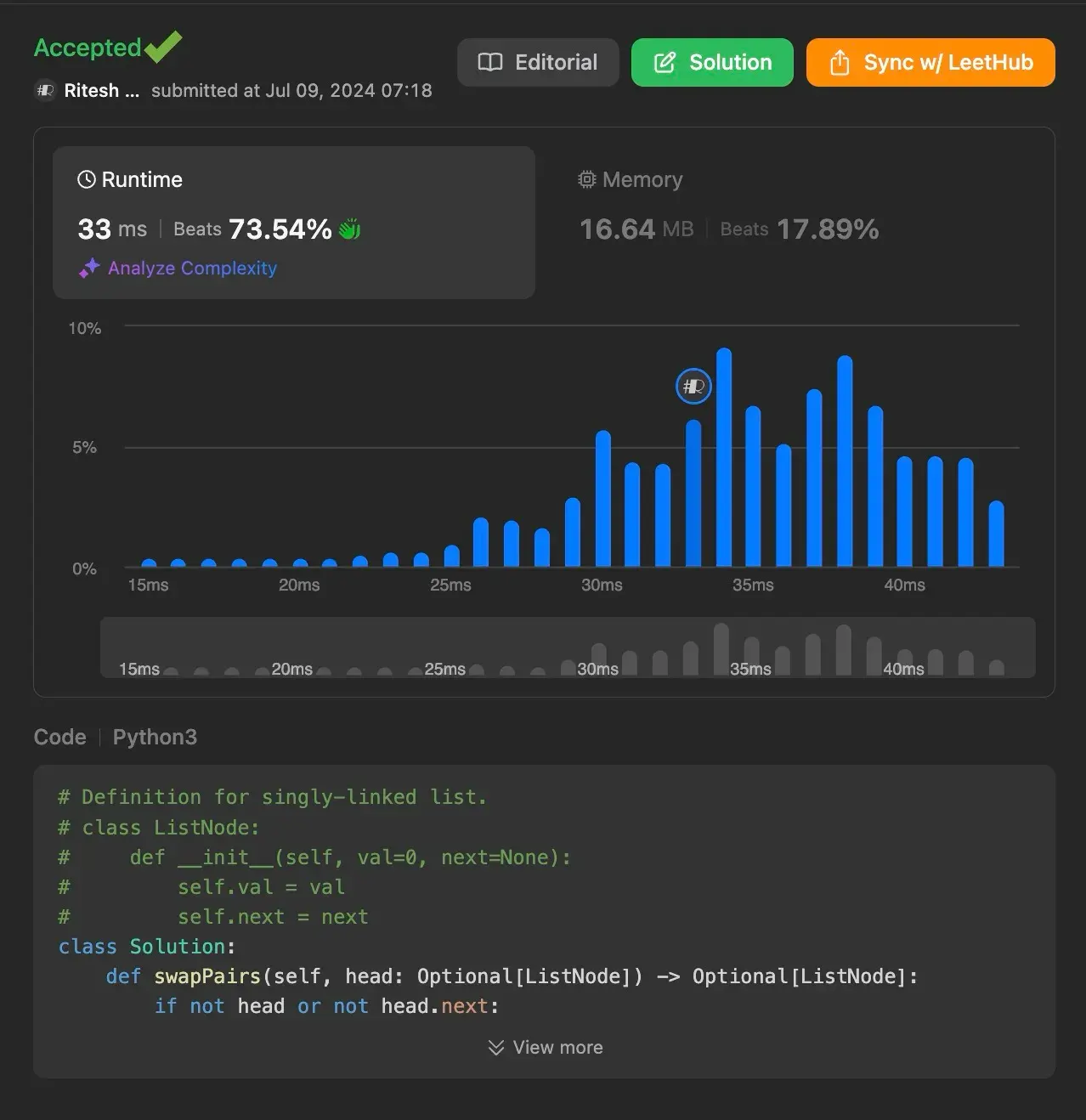In this article, we’ll explore how to swap every two adjacent nodes in a singly linked list, a common problem that can test our understanding of linked list manipulation and pointer handling. Let’s get started!

If you’re just joining us, it might be helpful to catch up on the previous entries. Want to see more problem-solving techniques? Follow me here on my blog!


Understanding the Problem
Given a linked list, the task is to swap every two adjacent nodes and return the head of the modified list. The important constraint here is that we are not allowed to modify the values of the nodes themselves but only the nodes. This means that our solution must involve changing the pointers of the nodes rather than their values.
Let’s look at some examples:
Example 1:

Input: head = [1,2,3,4]
Output: [2,1,4,3]
Example 2:
Input: head = []
Output: []
Example 3:
Input: head = [1]
Output: [1]
Using Efficient Approach: Pointer Manipulation
To solve this problem efficiently, we will use a pointer manipulation approach. The idea is to use a dummy node to simplify edge cases and then iterate through the list, swapping nodes in pairs.
def swapPairs(self, head: Optional[ListNode]) -> Optional[ListNode]:
if not head or not head.next:
return head
dummy = ListNode()
curr = head
prev = dummy
while curr and curr.next:
prev.next = curr.next
curr.next = prev.next.next
prev.next.next = curr
prev = curr
curr = curr.next
return dummy.next
Explanation
- Initial Checks: The function starts by checking if the list is empty or has only one node. If so, it returns the head as no swapping is needed.
- Dummy Node: A dummy node is created to handle edge cases easily. This node does not hold any value but points to the head of the list.
- Pointers Initialization: Three pointers are initialized:
currpoints to the current node being processed (initially the head of the list).prevpoints to the node before the current pair (initially the dummy node).
- Swapping Nodes: The loop runs as long as there are pairs to swap:
prev.nextis set to point to the second node of the current pair.curr.nextis adjusted to point to the node after the pair.- The second node’s
nextis adjusted to point to the first node. prevandcurrpointers are then moved forward to the next pair of nodes.
- Return New Head: Finally, the new head of the modified list is returned, which is
dummy.next.
Variable States for Each Iteration
Let’s walk through an example with the list [1, 2, 3, 4]:
- Initial State:
dummy -> [0] -> [1] -> [2] -> [3] -> [4]
curr -> [1]
prev -> [0]
- First Iteration:
# Swapping nodes [1] and [2]
prev.next -> [2]
curr.next -> [3]
prev.next.next -> [1]
# Update pointers:
prev -> [1]
curr -> [3]
- Second Iteration:
# Swapping nodes [3] and [4]
prev.next -> [4]
curr.next -> None
prev.next.next -> [3]
# Update pointers:
prev -> [3]
curr -> None
Time Complexity: O(n) - We traverse the list once, making the operation linear in relation to the number of nodes.
Space Complexity: O(1) - We only use a few extra pointers, making the space overhead constant.

Conclusion
In this article, we tackled the problem of swapping every two adjacent nodes in a linked list by using an efficient pointer manipulation approach. We explored the problem, broke down the solution, and understood the code step-by-step.
By mastering this approach, you’re well-equipped to handle more complex linked list manipulation problems.
Found this helpful? Follow me for more leetcode adventures! Questions? React out via email.
